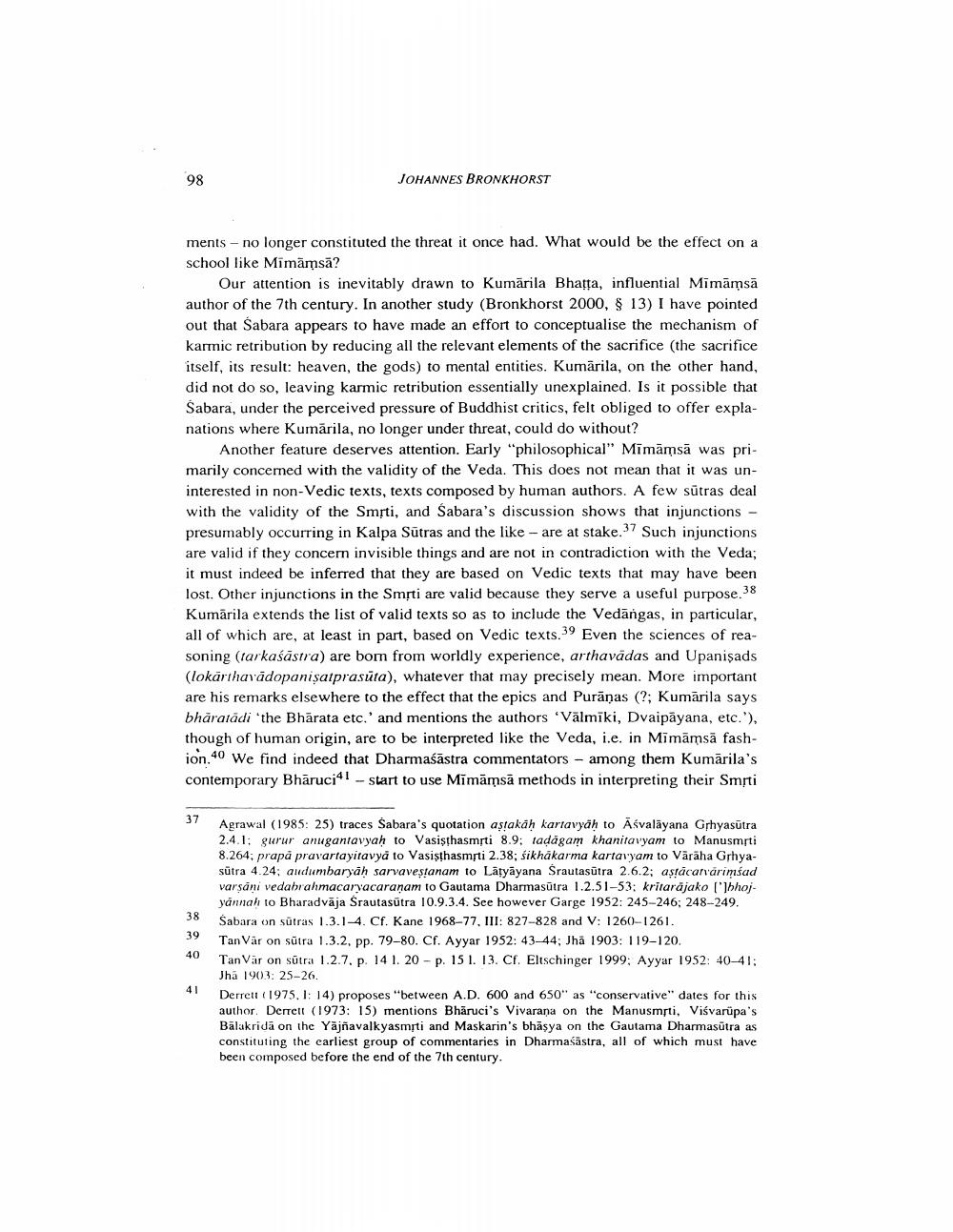________________
98
JOHANNES BRONKHORST
ments - no longer constituted the threat it once had. What would be the effect on a school like Mimāmsā?
Our attention is inevitably drawn to Kumārila Bhatta, influential Mimāmsā author of the 7th century. In another study (Bronkhorst 2000, $ 13) I have pointed out that Sabara appears to have made an effort to conceptualise the mechanism of karmic retribution by reducing all the relevant elements of the sacrifice (the sacrifice itself, its result: heaven, the gods) to mental entities. Kumärila, on the other hand, did not do so, leaving karmic retribution essentially unexplained. Is it possible that Sabara, under the perceived pressure of Buddhist critics, felt obliged to offer explanations where Kumarila, no longer under threat, could do without?
Another feature deserves attention. Early "philosophical" Mimāmsā was primarily concerned with the validity of the Veda. This does not mean that it was uninterested in non-Vedic texts, texts composed by human authors. A few sutras deal with the validity of the Smrti, and Sabara's discussion shows that injunctions - presumably occurring in Kalpa Sūtras and the like - are at stake.37 Such injunctions are valid if they concern invisible things and are not in contradiction with the Veda; it must indeed be inferred that they are based on Vedic texts that may have been lost. Other injunctions in the Smộti are valid because they serve a useful purpose.38 Kumārila extends the list of valid texts so as to include the Vedāngas, in particular, all of which are, at least in part, based on Vedic texts.39 Even the sciences of reasoning (tarkaśāstra) are bom from worldly experience, arthavadas and Upanişads (lokārthavādopanisatprasūta), whatever that may precisely mean. More important are his remarks elsewhere to the effect that the epics and Purānas (?; Kumārila says bhāratādi 'the Bhārata etc.' and mentions the authors 'Vālmīki, Dvaipāyana, etc.). though of human origin, are to be interpreted like the Veda, i.e. in Mimāmsā fashion.40 We find indeed that Dharmaśāstra commentators - among them Kumārila's contemporary Bharucio! - start to use Mimāmsā methods in interpreting their Smrti
37
Agrawal (1985: 25) traces Sabara's quotation astakaḥ kartavyäh to Asvalāyana Grhyasūtra 2.4.1: gurur anugantavyan to Vasisthasmrti 8.9: tadagam khanita vyam to Manusmrti 8.264, prapa pravartayitavyå to Vasisthasmrti 2.38; śikhäkarma karta yam to Väräha Grhyasūtra 4.24; audumbaryāḥ sarvavestanam to Lātyāyana Srautasūtra 2.6.2; astācanvārimsad varsani vedabrahmacaryacaranam to Gautama Dharmasūtra 1.2.51-53; kritarājako (']hhojyánnah to Bharadvāja Srautasūtra 10.9.3.4. See however Garge 1952: 245-246; 248-249. Sabara on sutras 1.3.1-4. Cf. Kane 1968–77, III: 827-828 and V: 1260-1261. Tan Vär on sūtra 1.3.2, pp. 79-80. Cf. Ayyar 1952: 43-44; Jha 1903: 119-120 Tan Vär on sūtra 1.2.7. p. 14 I. 20 - p. 151. 13. Cf. Eltschinger 1999: Ayyar 1952: 40–41; Jhã 194) 3: 25-26. Derrell (1975. 1: 14) proposes "between A.D. 600 and 650" as "conservative" dates for this author. Derelt (1973: 15) mentions Bharuci's Vivarana on the Manusmrti. Visvarüpa's Balakrida on the Yājñavalkyasmīti and Maskarin's bhāsya on the Gautama Dharmasūtra as constituting the carliest group of commentaries in Dharmaśāstra, all of which must have been composed before the end of the 7th century.




